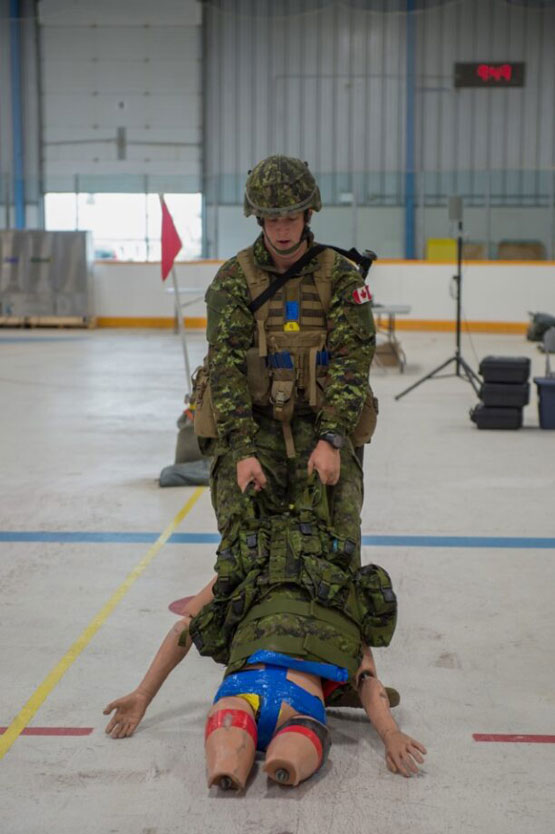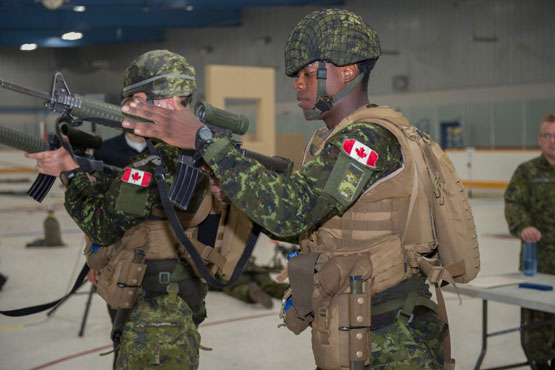August 16, 2023
Coping with heat hasn’t been easy this summer. For many, it’s been finding air conditioning, gaining access to pools or some other means of cooling down. It’s not that easy for CAF members in combat or in training – but Defence Research and Development Canada (DRDC) researchers are looking at solutions.
Heat stress comes from a combination of factors, including:
- Physical exertion
- Environment (sun, wind, temperature, humidity)
- Clothing
- Individual factors (such as recent illness or disease, which may impact a person’s ability to cool)
“A situation of 30°C outside, strong sun radiation, high humidity, and physical exertion – that’s the perfect storm,” said DRDC’s Dr. Matthew Cramer. “If a person wears clothing that does not allow evaporation of sweat – that person is in trouble.”
Clothing is designed either to help a person retain heat – or cool down by allowing sweat to evaporate. In a CAF context, however, that cooling aspect can be challenging in clothing designed to keep a person safe from external hazards such as ballistic injury, or injury due to chemical, biological, radiological or nuclear threats. Protective clothing – such as body armour, or clothes designed to protect from fire or chemicals – is not typically breathable, not allowing this evaporation of sweat to take place.


Soldiers participating in training exercises to support research on armour and heat stress
“Ideally, we have a clothing system that addresses the protection needs as well as the thermal needs,” Dr. Cramer added. “We have to identify trade-offs and threshold levels to come up with solutions that meet both needs.”
There is also the factor of physical exertion: CAF members often have to carry ammunition, tools or other items to allow them to carry out their functions. All are important considerations.
Heat impacts can range from relatively mild and uncomfortable – to life-threatening. A person may faint from the heat – but wake up feeling poorly within minutes. They may get cramps and body pains. However, if the cardio-vascular system is overwhelmed, it’s heat exhaustion. “Heat injury” happens when over-heating impacts internal tissues, resulting in kidney or liver dysfunction. “Heat stroke” happens when the body temperature goes above 40°C, and is considered a medical emergency. It involves tissue injury, as well as inflammation and problems with blood coagulation. This could lead to multi-organ failure and possibly death.
In a training exercise, heat factors can be addressed through mandatory breaks and hydration. However, in combat, those options don’t always exist. DRDC researchers are looking closely at what clothing – or what combination of clothing – lead to different scenarios. In turn, they will be able to give advice on what combination of clothing could help CAF members walk the line between heat injury and ballistic injury.

Soldiers participating in training exercises to support research on armour and heat stress
Preparation is key, when time permits. A person can acclimatize to the heat, and increase their aerobic exercise to prepare their cardio-vascular system.
However, the research happening at DRDC is producing threshold limits that will lead to guidelines for extreme heat. Researchers are looking at materials used to protect a person, the coverage of person’s body needed, and the placement of the armour on a person’s body. For example, the project team has investigated whether modular body armour – a system with less soft armour coverage for situations with a lower threat level – may help a person manage heat better. Findings suggest that lower levels of soft armour coverage are felt to be more comfortable for users but do not appreciably affect body temperatures. Research is ongoing.
“When designing protective clothing, the balance between risks for ballistic injury versus heat injury needs to be considered,” said Dr. Cramer. “The focus of course is on protection – we aim to work around that to produce clothing or clothing combinations that work.”
